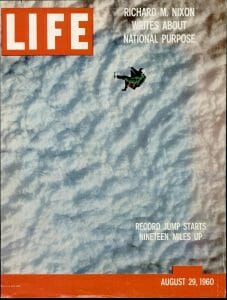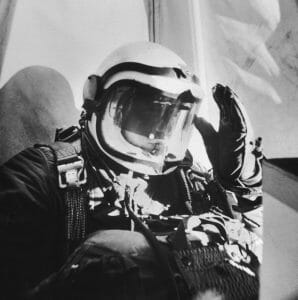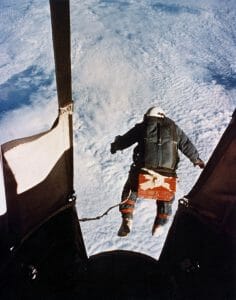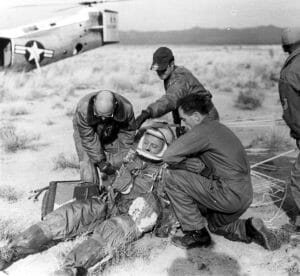Born and raised in Florida, Kittinger became fascinated with airplanes at a young age, and soloed in a Piper Cub by the time he was 17. Not surprisingly, he joined the U.S. Air Force, commissioned as a second lieutenant. He was assigned to the 86th Fighter-Bomber Wing based at Ramstein Air Base in West Germany, flying fighters. Within a few years he apparently became bored: In 1954, Kittinger was transferred to the Air Force Missile Development Center at Holloman AFB, New Mexico. There, he flew the chase plane that followed the rocket sled carrying flight surgeon Col. John Stapp [Honorary Unsubscribe, Volume 1], which was mounted on a track and hit 632 mph (1,017 kph) in 1955. Kittinger was fascinated by what Col. Stapp put himself through in the pursuit of improving aerospace medicine, which would help people like himself. He decided to follow in Stapp’s footsteps.

Stapp noticed Kittinger, too, and recommended him for early space research, notably Project Manhigh. In that program, men were sent aloft in capsules under balloons to get as high as possible to see the effects of cosmic rays on humans. Manhigh I, on June 2, 1957, with Kittinger aboard, had problems. First, his two-way radio failed. Worse, one of the capsule’s pressure valves was installed backwards, so his oxygen was being vented out. He still set a record: 29,500m (96,800 ft). Two other USAF officers made flights after going through the same battery of psychological and medical tests designed by Dr. Stapp; those same tests were used for qualifying astronauts for the first space flights in Project Mercury. Both of them broke Kittinger’s altitude record.

Capt. Kittinger stayed with Stapp for the next series of experiments, conducted by the Aerospace Medical Research Laboratories at Wright-Patterson AFB in Dayton, Ohio. Project Excelsior wasn’t just about going up very high under balloons: it was going up very high and then jumping out wearing a pressure suit (against the unbreatheably thin atmosphere). The fearless Kittinger was perfect for the job, and he was made Test Director. The first attempt again had a problem: his faceplate fogged up, and he couldn’t see the instruments, so he missed the bailout point — and didn’t notice until he was three miles higher than the target. But then he was stuck in his seat, and it took several minutes for him to free himself and jump. Then near disaster: the cord of the stabilizing drogue parachute got caught around his neck, which partially cut off his breathing and, worse, it didn’t inflate, so he went into a 120 RPM spin, rendering him unconscious. Luckily the experiment’s design included an automatic parachute, which deployed a mile above the ground. When he came to he thought he was dead, but then noticed the ’chute above him. “I am impossibly, wonderfully alive!” he thought to himself. So he tried it again less than a month later. That one was more successful, but from only about 74,700 ft (22,800m). The final try took nine months of planning, but it was a doozie: on August 16, 1960, Kittinger ascended in the pressurized balloon gondola to 102,800 ft (31,300m), at 19-1/2 miles higher than any human had gone in an unpowered craft, and again he jumped out. It was also the highest skydive ever, and he reached the highest skydiving speed ever: 614 mph (988 kph). He was 32 years old.

“There’s no way you can visualize the speed,” Kittinger said later. “There’s nothing you can see to see how fast you’re going. You have no depth perception. You don’t have a 614-mph wind blowing on you. I could only hear myself breathing in the helmet.” Life magazine proclaimed him a “new space hero” who had survived “the longest free fall in history.” Kittinger said for 50 years he got phone calls from “people wanting to break my record — one a month, sometimes two a month. But I stayed away from them because they didn’t have any idea what the challenge was.” Until, that is, he heard the plan for Felix Baumgartner, who spent three years planning to break the record. Baumgartner would only allow one person to talk to him on the radio during his attempt: Kittinger. By the time Baumgartner made his (successful) attempt, Kittinger was 84 years old, and he was on the radio piped into Baumgartner’s helmet. [See the story of that in my blog, There Are Still Adventures.]

Kittinger didn’t rest on his laurels: for Project Stargazer (December 13–14, 1962), he and the astronomer William White took an open-gondola helium balloon packed with scientific equipment to about 82,200 feet (25,100 m), and spent more than 18 hours performing astronomical observations, and then returned to operational status in the USAF, serving three tours in Vietnam, where he flew 483 combat missions. He was shot down on May 11, 1972, just before the end of his third tour of duty. He and his weapons systems officer, 1st Lt. William J. Reich, were held as POWs for 11 months at the “Hanoi Hilton”, where they were subjected to torture. Upon return to the U.S. as a full Colonel, Kittinger became the vice commander of the 48th Tactical Fighter Wing at RAF Lakenheath, United Kingdom. He retired in 1978, and in 1983 he set a distance record in a balloon, flying just over 2,000 miles in a single flight, and in 1984 was the first to fly a balloon solo across the Atlantic ocean. It took lung cancer to kill him — Joseph William Kittinger II died on December 9, at 94.
